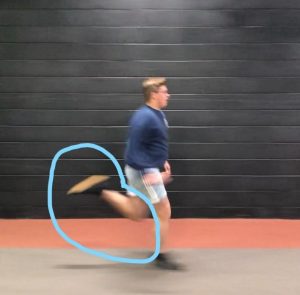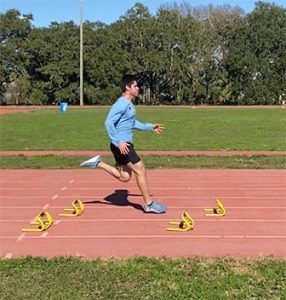The hip flexors are often neglected in training programs, and this article will outline the importance of training them and will give you several exercises to strength the hip flexors.
Sprinting is a movement that requires tremendous coordination throughout the body. Not only do the limbs need to move in perfect rhythm with optimal synchronization of the muscles, there also needs to be smooth transmission of the neurological signals sent throughout the body. 
Unfortunately, a lot of coaches overlook important aspects of sprinting because they tend to focus on the big blocks of speed training such as technique, strength of the big muscle groups, and mobility through our major joints.
While all of those things are important, I want to address the hip flexor group which is one of the most often overlooked aspects of sprinting. Hip extension has been getting a lot of publicity over the years, but many of us forget to include hip flexion exercises into our training programs.
Understanding the Hip Flexors
The hip flexor is a muscle group made up of the Iliacus and Iliopsoas, with assistance from the Rectus Femoris and Sartorius muscles. The hip flexor muscle group is responsible for flexing the hip, or, bringing the knee up toward the shoulders.
As you can imagine, this motion is imperative to movement. Even the act of walking requires this muscle group to lift the thigh with each step. You can also imagine the amount of work this muscle group does during athletic events. Not only lifting the leg repeatedly, but also doing so in a powerful and explosive fashion when the athlete is required to accelerate.
More than just its ability to lift the leg, the hip flexor group is responsible for the body’s ability to slow the leg down as it passes behind the body after toe-off during a stride. The hip flexors go through a rapid lengthening followed by a rapid shortening as they help bring the leg forward during the swing phase.
This motion requires a great deal of eccentric strength from the hip flexors in order to control the lengthening of the muscle before the explosive concentric contraction. This muscular quality can be the difference between a fast, efficient athlete and an athlete who will struggle greatly in competitive sport.
There are multiple factors at play here including: hip orientation during movement, core strength and involvement, and the position of toe off relative to center of gravity. We’ll save these elements for another time in order to focus on how hip flexor strength affects running form and technique. 
When you hear coaches talk about running mechanics you often hear them refer to front side and back side mechanics. This simply refers to what is happening to the leg on the front side or back side of the body and is an easy way for coaches to assess and cue athletes to understand their motion. As the leg passes under the body during the stance phase, it alternates from a front side to a back side position. As the leg passes under the body, the foot stays on the ground for a short period of time before it begins to travel upward and behind the hip. This backside position (circled on the photo) is the position I would like to address.
The characteristics and capacity of the hip flexor muscle group have a dramatic affect on what happens in this back side position. They will impact how far back the leg travels, the height of the foot above the ground, the path of swing back to the front side, the time is takes for the leg to travel back to the front side and eventually how high the knee travels upward in the front side before moving back down.
Here are two examples of athletes, in stride, doing exactly what we are addressing.


As you can see with the athlete on the left, the back leg travels much further backward away from the body as compared to the athlete on the right. Also, you will notice the orientation of the leg compared to the timing of the stride. Both athletes are approaching touchdown within their stride, however, one athlete is still completely extended behind the body while the other athlete is in the mid-swing phase preparing to enter front side swing. This will obviously have an effect on the timing of the movement. For the athlete on the left, with the back leg extended at this point in the stride, she will have very little time to get the leg back into a front side position to prepare for the next stride.
Now, as mentioned before, there could be a number of factors at play here, so I don’t want to make it seem like hip flexor strengthening will fix everything.
Assuming the athlete is able to maintain proper posture and orient the hips in a neutral position, the hip flexor can now be evaluated in its effectiveness and control.
When observing an athlete from the side during upright sprinting you can begin to evaluate the hip flexors capacities in movement. When you observe athletes that have an extended rear leg with a high heel kick (as you see in the athlete on the left), you can begin to assume that they likely have less eccentric strength within their hip flexors.
As the foot travels backward under the body and into the air, the hip flexor is working to slow the limb in order to re-accelerate it forward. Athletes with good hip flexor strength will be able to move the leg back under the hip much earlier in the stride such as what you see with the athlete on the right.
The concentric strength of the hip flexor is also very important and has the responsibility of lifting the knee upward prior to the leg driving down to the ground. However, like with the back side heel kick, there are many other factors to take into account.
Training the Hip Flexors
Knowing the importance of hip flexor strength in running, what can we do about it? I believe one of the most beneficial and specific things we can do with athletes is high-volume form running drills. Whether it be the A series, B series, or C series, there is high demand on the hip flexors. Doing this over extended distances and/or times allows us to create a specific means of strengthening and conditioning the hip flexors. The technical benefits of these drills should not be overlooked, but the impact they have on the hip flexors is often overlooked.
Other tools that can be used include hanging and supine leg lifts, ankle band resistance exercises, resistance band exercises, or a multi-hip machine if available. These are all very beneficial and should make their way into a training program especially when weak hip flexors are suspected. Incorporating isometric holds and eccentric resistance in the movements is also recommended.
Here are some additional examples of hip flexion strengthening exercises that can be incorporated into your routines:
These are just a few examples of exercises, but how you choose to train the hip flexors will depend on how the rest of your training is implemented and the equipment available The key is that it is being addressed. High-volume training is unnecessary, and you will typically train the hip flexors after your speed work and the main lower-body lifting exercises. When athletes begin to sprint and train the hip flexors, they often get quite sore, so be sure to start slowly and give them time to recover between sessions while they adapt to the new stimulus.
Take some time to assess your athletes running mechanics and hip flexor strength, and start to include hip flexion exercises into your programs. You’ll be amazed at what a difference it makes as you watch your athletes improve both their mechanics and speed.

Nick Brattain is the owner of Brattain Sports Performance in Louisiana. Nick is also the High Performance Coach for Isidore Newman School as well as the Louisiana State Director for the National High School Strength Coaches Association. As a graduate from the University of Indianapolis, Nick was an All-American Sprinter on the track team. Since then Nick has dedicated his career to speed development in athletes of all ages.
For even more detailed information about sprinting mechanics and speed development, check out the IYCA Certified Speed & Agility Specialist course. The CSAS is the most comprehensive and scientifically sound speed certification in the athletic development profession. It truly prepares you to teach and develop speed in all athletes. Click on the image below to learn more.


